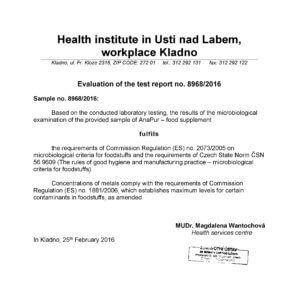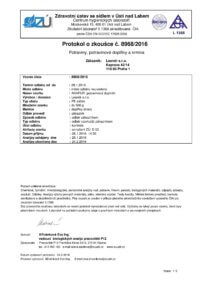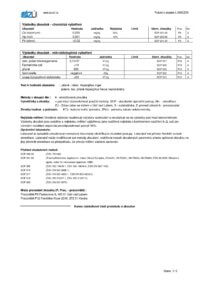Nature in the lab
AnaPur and laboratory test of shelf life
What’s the shelf life of AnaPur? Can it actually spoil at all? We often receive similar questions which led us to openly disclose the results of a laboratory test we carried out a couple of months ago.
We were interested in AnaPur’s shelf life, and whether there is anything harmful at the end of the “best-before” date.
Therefore, we decided to test AnaPur for undesirable substances with the chemical analysis and microbiology tests. The tested packaging already passed our recommended shelf life.
And the test result? In a nutshell, not only that AnaPur passed the test in the laboratory but it even met the strict requirements for baby food established by the EU. As a result, even at the end of the shelf life, AnaPur is suitable for consumption.
And now let’s get to the details:
As you may know, the riskiest (but at the same time very valuable) part of the composition are nuts, which provide a great source of unsaturated fatty acids, popularly known as the “healthy fats”. Unsaturated acids affect positively, among others, the heart and cholesterol. But because they are unsaturated, they tend to oxidize and thereby their benefit slowly disappears. The speed of this rancidity depends on temperature, humidity and other factors. Rancidity not only devalues the beneficial fats but may also turn them into unwanted substances such as heavy metals, fungi and bacteria.
Nature is not a laboratory. It is alive, and therefore its fruits cannot be sterile. This also applies to AnaPur, which is based on these raw ingredients and takes the best from the nature thanks to them. That’s exactly why it’s important to test the level of these substances included.
The limits allowed are determined by the EU regulations, eg. EC Regulation no. 1881/2006, setting maximum levels for certain contaminants in foodstuffs or EC Regulation no. 2073/2005 on microbiological criteria for foodstuffs.
For the analysis, we used the services of accredited laboratories of the Health Institute in Usti nad Labem, where we delivered the sample. Before the testing itself, the sample was stored in normal room conditions for 4 months, i.e. at the end of its recommended shelf life.
See the results on pictures, their interpretation can be found below:



Results:
Cadmium
Measured: 0.055 mg / kg
Maximum levels: Cereals, excluding bran, germ, wheat and rice, 0.1 mg / kg, bran, germ, wheat and rice: 0.2 mg / kg, Soybeans: 0.2 mg / kg, Vegetables and fruits, except leaf, herbs, brassica, fungi and seaweed root or 0.05 mg / kg, leafy vegetables: 0.2 mg / kg, supplements: 1.0 mg / kg, food supplements consisting exclusively or mainly of dried seaweed , products derived from seaweed, or of dried bivalve molluscs: 3.0 mg / kg.
Mercury
Measured: 0.001 mg / kg
Maximum levels: Supplements: 0.1 mg / kg
Lead
Measured: <0.02 mg / kg
Maximum levels: Initial and follow-on formulas: 0.02 mg / kg of raw milk, heat-treated milk: 0.02 mg / kg. Generally, the presence of lead should not exceed 0.02 mg / kg for baby food
Escherichia coli
Measured: <10 cfu / g
Maximum levels: Cheese made from heat-treated milk or whey 100 cfu / g; shelled and shucked products of cooked crustaceans and shellfish: satisfactory, if less than 1 CFU / g, acceptable if less than 10 cfu / g; Precut fruit and vegetables / ready to eat / 100 cfu / g; unpasteurised fruit and vegetable juices / ready to eat / 100 cfu / g
Aspergillus niger
Measured: 600 cfu / g potency. tox. Aspergillus flavus Not Detected
Maximum levels: There is no benchmark, it’s normally present in food
An occurrence is not surprising since it is the most widespread contaminant which occurs in the food, fruits, spices, etc. E.g. A study comparing the presence of Aspergillus niger in loose medicinal teas showed that even values above 600 cfu / g are common.
Salmonella
Measured: negative
Coagulase positive staphylococci
Measured: <50 cfu / g
Maximum level: Milk powder and whey powder: 10 cfu / g compliant, to 100 cfu / g acceptable, shelled and shucked products of cooked crustaceans and molluscan shellfish: 100 cfu / g
And what does that mean?
Heavy metals and microbiological undesirable substances are absent in AnaPur, respectively are present in normal allowed amount. Even at the end of the recommended shelf life, AnaPur fulfils comfortably all the requirements according to the European legislation on food safety. The four-month shelf life we set is given in order to express how long the mixture remains fresh and in the best nutritional shape. Indeed, it’s possible to consume AnaPur even after this period. However, we recommend to eat it as fresh as possible. Storage is also important. The perfect solution is to put AnaPur in the dark cupboard with constant room temperature and low humidity. This contributes to the longer durability of AnaPur without any undesirable substances. The same way as the laboratory analysis has proven it.
.png)